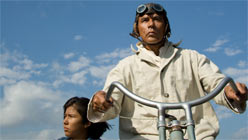As a Jewish writer who’s covered the S.F. Jewish Film Festival for more than 20 years, I’m no longer surprised by the array of movies produced annually about every niche and nook of the Jewish experience. But the breadth of locations and issues in the 34th annual American Indian Film Festival caught me unawares. My bad, obviously. (That innocuous bit of contemporary nomenclature may read in this context like a send-up of Tonto’s pidgin English. That’s OK by me.)
The AIFF opens with a documentary, not a wholly unexpected choice given the paucity of nonfiction narratives about Native Americans. Affirmational without being the slightest bit sentimental, personal yet profoundly universal, Kate Raisz’s graceful, eloquent People of the Seal illuminates the history and culture of the indigenous people living on Saint Paul Island in the Aleutians, 400 miles off the coast of Alaska in the Bering Sea.
Unangan life revolved for hundreds of years around the sea otter and more recently the fur seal, surviving the depredations of the Russian fur trade (and the more benign Russian Orthodox missionaries) and the U.S. government’s third-class treatment following the 1867 purchase of Alaska. More recently, the 1983 Federal ban on commercial harvesting of fur seals, instigated by well-meaning environmental activists, has depressed (in both senses) the community.
People of the Seal skillfully delineates the big issues of exploitation, geopolitics, assimilation and environmental health through the fascinating family tree of sixth-generation native Aquilina Debbie Lestenkof. Rest assured that neither Aquilina nor anyone else in this terrific film espouses a cause or asks for sympathy — the Unangan accept reality, and embrace the responsibility of sustaining their culture. Simultaneously meditative and direct, packed with historical info but overridingly sensitive to individual lives, People of the Seal has something for everyone.
Closer to home, the festival closes with Sterlin Harjo’s deeply felt, Oklahoma-set indie feature Barking Water. A bittersweet, late-in-life trek that, unfortunately, covers more geographical territory than spiritual or narrative, the story begins with an orderly springing the terminally ill Frankie (Richard Ray Whitman) from the hospital. His erstwhile lady love, Irene (Casey Camp-Horinek), waits in the parking lot to ferry him to a rendezvous and (hopefully) reconciliation with his estranged daughter and her newborn.


